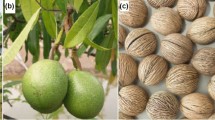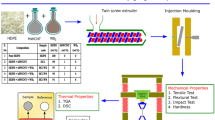Abstract
Viscose fibers were treated with atmospheric pressure dielectric barrier discharge (DBD) plasma obtained in nitrogen in order to activate the fiber surface prior to sorption of the divalent ions Ca2+ and Cu2+. Methylene blue sorption was used for estimation of carboxyl group formation on the surface after DBD plasma treatment, through the degree of fabric staining (K/S). Sorption of divalent ions was performed from solutions of each individual ion and from solutions of calcium and copper in succession onto untreated and plasma-treated viscose samples. The quantity of sorbed metal was determined from the neutralization and iodometric titration method. Scanning electron microscopy coupled with energy dispersive X-ray analysis was used for fiber morphology and surface characterization before and after plasma treatment, and after metal ions sorption. Experiments revealed copper microparticles formation on the fiber surface when sorption of copper was performed on samples with bonded calcium. Further analysis confirmed that for growth of copper particles, both calcium ions and nitrogen DBD plasma pretreatments are necessary.







Similar content being viewed by others
References
Acemioglu B, Alma MH (2001) Equilibrium studies on adsorption of Cu(II) from aqueous solution on cellulose. J Colloid Interf Sci 243:81–84
Anand SC, Horrocks AR (2000) Handbook of technical textiles. Woodhead Publishing Limited, Cambridge
Butler O (1923) Chemical, physical, and biological properties of Bordeaux mixtures. Ind Eng Chem 15:1039–1041
Butler O (1928) Making Bordeaux mixture. Am J Potato Res 5:187–190
Cady NC, Behnke JL, Strickland AD (2011) Copper-based nanostructured coatings on natural cellulose: nanocomposites exhibiting rapid and efficient inhibition of multi-drug resistant wound pathogen, A. Baumannii, and mammalian cell biocompatibility in vitro. Adv Funct Mater 21:2506–2514
Calvimontes A, Mauersberger P, Nitschke M, Dutschk V, Simon F (2011) Effects of oxygen plasma on cellulose surface. Cellulose 18:803–809
Dastjerdi R, Montazer M (2010) A review on the application of inorganic nano-structured materials in the modification of textiles: focus on anti-microbial properties. Colloid Surf B 79:5–18
Dixon B (2004) Pushing Bordeaux mixture. Lancet Infect Dis 4:594
Druz N, Andersone I, Andersons B (2001) Interaction of copper-containing preservatives with wood. Part 1. Mechanism of the interaction of copper with cellulose. Holzforschung 55:13–15
Edwards JV, Vigo TL (2001) Bioactive fibers and polymers. American Chemical Society, Washington, DC
Emam HE, Manian AP, Siroka B, Bechtold T (2012) Copper inclusion in cellulose using sodium D-gluconate complexes. Carbohyd Polym 90:1345–1352
Fan N, Xu L, Li J, Ma X, Qian Y (2007) Selective synthesis of plate like and shrub-like microscale copper crystallites. J Cryst Growth 299:212–217
Fitz-Binder C, Bechtold T (2012) Ca2+ sorption on regenerated cellulose fibres. Carbohyd Polym 90:937–942
Flora T (1984) Die analyse der Bordeaux-Mischung. Thermochim Acta 76:25–46
Fras L, Stana-Kleinschek K, Ribitsch V, Sfiligoj-Smole M, Kreze T (2002) Quantitative determination of carboxyl groups in cellulose by complexometric titration. Lenzinger Berichte 81:80–88
Fras-Zemljič L, Peršin Z, Stenius P (2009) Improvement of Chitosan adsorption onto cellulosic fabrics by plasma treatment. Biomacromolecules 10:1181–1187
Huang L, Ou Z, Boving TB, Tyson J, Xing B (2009) Sorption of copper by chemically modified aspen wood fibers. Chemosphere 76:1056–1061
Jun W, Fengcai Z, Bingqiang C (2008) The solubility of natural cellulose after DBD plasma treatment. Plasma Sci Technol 10:743–747
Karahan HA, Ozdogan E, Demir A, Ayhan H, Seventekin N (2009) Effects of atmospheric pressure plasma treatments on certain properties of cotton fabrics. Fibres Text East Eur 17:19–22
Klemm D, Philipp B, Heinze T, Heinze U, Wagenknecht W (1998) Comprehensive cellulose chemistry volume l fundamentals and analytical methods. Wiley, Weinheim
Kontturi EJ (2005) Surface chemistry of cellulose: from natural fibers to model surfaces. Dissertation, Eindhoven, Technische Universiteit, Eindhoven
Kostic M, Radic N, Obradovic BM, Dimitrijevic S, Kuraica MM, Skundric P (2009) Silver-loaded cotton/polyester fabric modified by dielectric barrier discharge treatment. Plasma Process Polym 6:58–67
Kramar A, Prysiazhnyi V, Dojčinović B, Mihajlovski K, Obradović BM, Kuraica MM, Kostić M (2013) Antimicrobial viscose fabric prepared by treatment in DBD and subsequent deposition of silver and copper ions—investigation of plasma aging effect. Surf Coat Technol 234:92–99
Malek RMA, Holme I (2003) The effect of plasma treatment on some properties of cotton. Iran Polym J 12:271–280
Mather RR (2009) Surface modification of textiles by plasma treatments. In: Wei Q (ed) Surface modification of textiles. Woodhead Publishing Limited, Cambridge, pp 296–317
Narayan G (1949) Studies on the chemistry of Bordeaux mixture—part I. Proc Indian Acad Sci Math Sci 29:367–379
Nikiforova TE, Kozlov VA (2012) Sorption of copper(II) cations from aqueous media by a cellulose-containing sorbent. Prot Met Phys Chem Surf 48:310–314
Norkus E, Vaiciuniene J, Vuorinen T, Macalady DL (2004) Equilibria of Cu(II) in alkaline suspensions of cellulose pulp. Carbohyd Polym 55:47–55
Ozturk HB, Vu-Manh H, Bechtold T (2009) Interaction of cellulose with alkali metal ions and complexed heavy metals. Lenzinger Berichte 87:142–150
Peršin Z, Stenius P, Stana-Kleinschek K (2011) Estimation of the surface energy of chemically and oxygen plasma-treated regenerated cellulosic fabrics using various calculation models. Text Res J 81:1673–1685
Potthast A, Rosenau T, Kosma P (2006) Analysis of oxidized functionalities in cellulose. Adv Polym Sci 205:1–48
Praskalo-Milanovic JZ, Kostic MM, Dimitrijevic-Brankovic SI, Skundric PD (2010) Silver-loaded lyocell fibers modified by TEMPO-mediated oxidation. J Appl Polym Sci 117:1772–1779
Prysiazhnyi V, Kramar A, Dojcinovic B, Zekic A, Obradovic BM, Kuraica MM, Kostic M (2013) Silver incorporation on viscose and cotton fibers after air, nitrogen and oxygen DBD plasma pretreatment. Cellulose 20:315–325
Saito T, Isogai A (2005) Ion-exchange behaviour of carboxylate groups in fibrous cellulose oxidized by the TEMPO-mediated system. Carbohyd Polym 61:183–190
Shahidi S, Rashidi A, Ghoranneviss M, Anvari A, Rahimi MK, Moghaddam MB, Wiener J (2010) Investigation of metal absorption and antibacterial activity on cotton fabric modified by low temperature plasma. Cellulose 17:627–634
Shishoo R (2007) Plasma technologies for textiles. Woodhead Publishing Limited, Cambridge
Song J, Birbach NL, Hinestroza JP (2012) Deposition of silver nanoparticles on cellulosic fibers via stabilization of carboxymethyl groups. Cellulose 19:411–424
Sun D, Stylios GK (2004) Effect of low temperature plasma treatment on the scouring and dyeing of natural fabrics. Text Res J 74:751–756
Sundman O, Persson P, Ohman LO (2008) A multitechnique study of the interactions between H+, Na+, Ca2+ and Cu2+ and two types of softwood Kraft fibre materials. J Colloid Interf Sci 328:248–256
Vainio U, Pirkkalainen K, Kisko K, Goerigk G, Kotelnikova NE, Serimaa R (2007) Copper and copper oxide nanoparticles in a cellulose support studied using anomalous small-angle X-ray scattering. Eur Phys J D 42:93–101
Wu M, Kuga S, Huang Y (2008) Quasi-one-dimensional arrangement of silver nanoparticles templated by cellulose microfibrils. Langmuir 24:10494–10497
Xia J, Li H, Luo Z, Wang K, Yin S, Yan Y (2010) Ionic liquid assisted hydrothermal synthesis of three-dimensional CuO peachstone-like structures. Appl Surf Sci 256:1871–1877
Xu S, Sun X, Ye H, You T, Song X, Sun S (2010) Selective synthesis of copper nanoplates and nanowires via a surfactant-assisted hydrothermal process. Mat Chem Phys 120:1–5
Yudanova TN, Skokova IF, Galbraikh LS (2000) Fabrication of biologically active fibre materials with predetermined properties. Fibre Chem 32:411–413
Zhukovskii VA (2005) Current status and prospects for development and production of biologically active fibre materials for medical applications. Fibre Chem 37:352–354
Acknowledgments
Authors are very grateful to The Ministry of Education, Science and Technological Development of the Republic of Serbia for financial support through projects OI 172029 and OI 171034.
Author information
Authors and Affiliations
Corresponding author
Rights and permissions
About this article
Cite this article
Kramar, A.D., Žekić, A.A., Obradović, B.M. et al. Study of interaction between nitrogen DBD plasma-treated viscose fibers and divalent ions Ca2+ and Cu2+ . Cellulose 21, 3279–3289 (2014). https://doi.org/10.1007/s10570-014-0346-8
Received:
Accepted:
Published:
Issue Date:
DOI: https://doi.org/10.1007/s10570-014-0346-8




